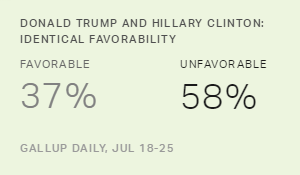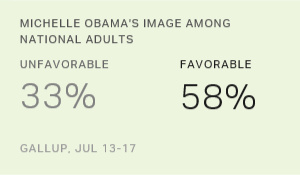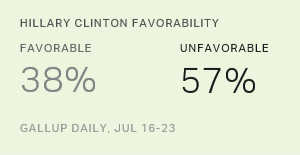The average American's views of Donald Trump and Hillary Clinton have converged for the first time in Gallup's yearlong tracking of the images of the two candidates, with Americans giving each exactly the same favorable and unfavorable ratings. The numbers for both candidates, based on interviewing conducted July 18-25, are 37% favorable and 58% unfavorable. In all previous Gallup updates stretching back to last July, Clinton's net favorable has been higher than Trump's.
The current period covers the four days of the Republican convention, but also includes the weekend in which Clinton announced her vice presidential running mate and the first night of the Democratic convention. In fact, when the data from Saturday, Sunday and Monday are isolated, the numbers are even slightly more in Trump's favor -- 37%/58% favorable/unfavorable, compared with Clinton's 36%/59%. In other words, there is no evidence through Monday night that Trump is losing his image gains from his Cleveland convention.
Trump is also still getting more attention than Clinton. From Saturday through Monday, 72% of Americans reported having read, seen or heard anything about Clinton "in the last day or two," compared with 76% who said the same about Trump. This slight edge for Trump occurred even as the convention focus began to shift away from the Republicans and toward the Democrats. The question asks about "the last day or two," so it's possible -- if not likely -- that Clinton will begin to edge out Trump on this measure as this week progresses. The impact the Democratic convention will have on her image remains to be seen. In fact, the convention's impact on her image in general is one of the most important issues facing her campaign. The Democrats' convention comes after the Republicans' this year, which gives Clinton the chance to make an impression on the average American that can carry forward. Whether she is able to do that, as noted, is the critical question.
Trump's image may be improving compared with Clinton's, but historically speaking, Americans' self-reports about the GOP convention's impact are mediocre.
For example, Trump's speech got the least positive reviews of any speech we have tested after the fact: 35% of Americans interviewed last weekend said it was excellent or good. Of the nine previous speeches we have rated, the top one was Barack Obama's in August 2008, which 58% of Americans rated as excellent or good. The lowest-rated speech other than Trump's was Mitt Romney's in 2012, with 38% excellent or good.
Among just those who reported that they watched "a great deal" of the GOP convention, Trump's speech rating was much better: 58% of this group rated Trump's speech as excellent or good (with only 1% not having an opinion or saying they didn't watch the speech). Of those who watched very little or none of the convention, 19% rated Trump's speech as excellent or good, with 26% saying they didn't watch or didn't have an opinion. But this same type of disparity has been evident in our previous reviews of reactions to acceptance speeches as well, and the key finding is that, putting it all together, Trump's speech received lukewarm ratings, based on historical comparisons.
The self-reported net impact of the GOP convention was also negative. Overall, 51% of Americans say the convention made them less likely to vote for Trump, while 36% said it made them more likely to vote for him. This is the highest "less likely to vote" percentage for a candidate in the 15 times Gallup has asked this question after a convention. The previous "less likely" high was 38% after both conventions in 2012, and after the GOP conventions in 2004 and 2008.
Of course, the data show that 73% of Republicans and Republican-leaning independents said the convention made them more likely to vote for Trump, compared with 2% of Democrats. In other words, reaction to the speech was basically a reinforcement of pre-existing attitudes.
My colleague Jeff Jones will be doing a more comprehensive analysis of these self-reports early next week, when we have comparable data from the Democratic convention.
At this point, we can say that although Americans' views of the Cleveland convention were not at all positive after it ended, the underlying trend data show that over the last week or so, Trump has managed to reach a milestone in his campaign: His image among Americans is now identical to that of his opponent.




